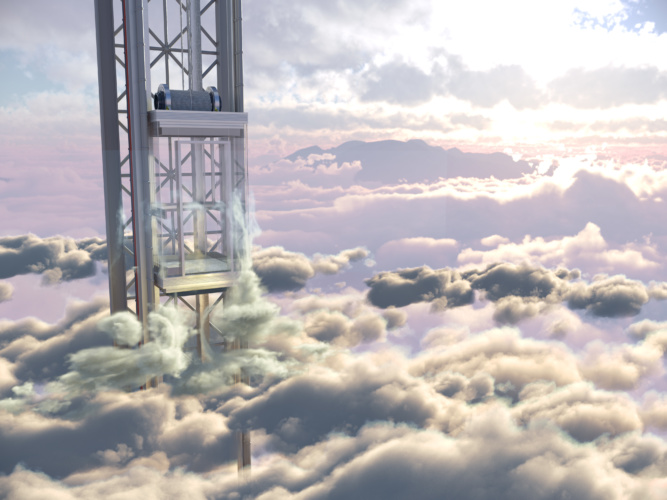The recent news item on magnetic product delivery caught my eye. In it, the London-based start-up, Magway, proposed a nationwide network of pipes along which freight could be moved using magnetic waves of electrical current. The idea is to remove freight from the roads and eliminate tonnes of CO2 emissions.

As a science fiction author, I’ve heard similar schemes before, from the pneumatic passenger tubes of the 1940s to Elon Musk’s Hyperloop. But the difference with this idea is that it doesn’t require a vacuum or low pressure in the tunnels, nor is it trying to solve the problem of transporting humans at supersonic speeds. Instead, its pallets trundle along at 31 mph, milliseconds apart.
I rather like the idea of being able to order a cup of tea and a bacon sandwich on a Sunday morning and have them arrive within minutes from my favourite café
London already has a low speed tube-based network for transporting passengers. It’s called the Underground, and it handles around 2 million people per day. Creating a network for freight makes a lot of sense. Rather than entrust the delivery of your takeaway dinner to a cycle courier, you could order it from a restaurant and collect it, still hot, at your local terminal. And if companies such as Amazon took to the new system, you could get almost anything you wanted delivered by underground tube.
Better yet, if each pallet carries its own RFID chip, you would be able to track its exact postion as it made its way towards you beneath the streets. No more waiting in for delivery drivers who may or may not show up within the time window they’ve given you. Instead, you can see your new flatpack armchair has just passed under the Thames and will be ready to collect in ten minutes.
Personally, I rather like the idea of being able to order a cup of tea and a bacon sandwich on a Sunday morning and have them arrive within minutes from my favourite café.
Science fiction has always been full of ingenious mass transit systems—some more plausible than others. Larry Niven wrote about moving pavements, which he dubbed “slidewalks,” while British author Peter F Hamilton envisions trains utilising a network of wormholes to travel around the globe, and even to other planets!
One of the most mindboggling concepts to have been dreamed-up is the space elevator—an idea used by scores of writers, including Arthur C. Clarke, Iain Banks, Kim Stanley Robinson, and Alastair Reynolds.
First proposed in 1895 by Konstantin Tsiolkovsky, the space elevator is simple to describe but harder to build. It involves a length of extremely strong material—maybe carbon nanotubes, maybe something else—reaching from the surface of the Earth to geosynchronous orbit. A counterweight on the far end keeps the structure taut. Passengers and freight can then be moved up and down in pressurised elevator cars, without relying on the uncertainties of rockets or parachutes.
Such a structure would drastically lower the cost and risk of shipping materials into orbit. Half a dozen towers, placed strategically around the equator, might make it economically feasible to move most of our manufacturing off-planet, cutting down on industrial pollution. It would also open the way for space tourism and travel to the moon and other planets—a true engineering marvel.
Can you imagine taking an elevator from an equatorial nation, and then watching as it rises smoothly into the air? The ground drops away, and then the curvature of the Earth becomes visible. And still you rise, until you’re 22,236 miles high. This is geosynchronous orbit. A satellite at this height will take the same amount of time to orbit the Earth as the Earth takes to revolve, so the satellite will appear to remain motionless above the same spot. Here there will be a space station. Maybe a luxury hotel, some corporate offices, and a staging area for transfer to some of the nearby stations and factories that share this orbit, strung between the various elevators like a diamond spider’s web.
It sounds like something out of Star Trek, but the realities of our strife-based world mean the ownership and operation of these towers would need to be carefully agreed in order to stop one group or nation gaining a monopoly on orbital access—and to stop the towers themselves becoming targets during wartime. In Red Mars, Kim Stanley Robinson depicts the fall of one such elevator after a terrorist attack. The falling cable wraps itself twice around the planet’s equator, causing huge amounts of death and destruction. Trust me, you do not want to be standing under one of those when they come crashing down!
Personally, I think I’ll stick with the London Underground. It has its frustrations, but also its charms—and unless you fall asleep on the Circle Line, you don’t have to travel 22,000 miles to get to work!
Gareth L Powell is the author of several novels, including Silversands, The Recollection, Ack-Ack Macaque, Hive Monkey, Macaque Attack, and Embers of War. He has won the BSFA Award for Best Novel twice, for Ack-Ack Macaque in 2013 and Embers of War in 2019.




Nanogenerator consumes CO2 to generate electricity
Whoopee, they've solved how to keep a light on but not a lot else.